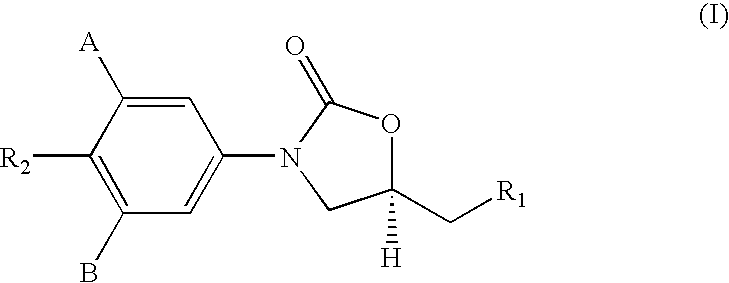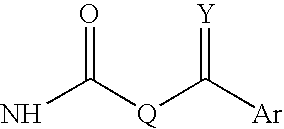Antimycobacterial compounds
a technology of mycobacterial compounds and compounds, applied in the field of oxazolidinones, can solve the problem of few antimycobacterial compounds, and achieve the effect of potent antimycobacterial properties
- Summary
- Abstract
- Description
- Claims
- Application Information
AI Technical Summary
Benefits of technology
Problems solved by technology
Method used
Image
Examples
example 1
General Method for Preparation of the Amines (II)
[0219]The oxazolidinone azides of general formula (8), given in Scheme-II (1.0 eq) were dissolved in dry THF (10 times by volume) and treated with triphenyl phosphine (1.5 eq.) at room temp. The resulting solution was stirred for 6 hrs at room temp. Water [2 eq. of (8)] was added and the solution heated for 6 hrs at 55-60° C. The solvent was evaporated and the residue chromatographed on a column of silica gel (100-200 mesh) and eluted initially with ethyl acetate and then with chloroform:methanol (4:1) to give the amines (II) as white solids.
[0220]The following amines i) to viii) of formula I were prepared by this general method, viz.[0221]i) (S)-N-[3-(3-fluoro-4-morpholinylphenyl)-2-oxo-5-oxazolidinyl]methyl amine,[0222]ii) (S)-N-[3-(3-fluoro-4-thiomorpholinylphenyl)-2-oxo-5-oxazolidinyl]methyl amine,[0223]iii) (S)-N-[3-(3-fluoro-4-piperidylphenyl)-2-oxo-5-oxazolidinyl]methyl amine,[0224]iv) (S)-N-[3-(3-fluoro-4-benzylpiperazinylphen...
example 2
4-(2-Naphthyl)-4-oxobutanoic acid
[0229]Naphthalene (5.0 gm, 0.039 moles) and succinic anhydride (4.68 gm, 0.0468 moles) were taken up in dichloroethane (50 ml). Aluminium chloride (11.44 g, 0.0858 moles) was added at room temperature and the resulting mixture heated under reflux for 1 hr with stirring. The reaction mixture was cooled to room temperature, diluted with 25 ml of 1:1 mixture of water and Conc. hydrochloric acid. After stirring for 10 min the separated solid was filtered under suction, washed with water and dilute hydrochloric acid. Subsequent column chromatography gave a buff coloured solid. Subsequent chromatography gave 3.7 gm (41%) the title compound, mp 173-174° C.
[0230]1H NMR (CDCl3, δ): 8.40 (s,1H), 7.7-8.0 (m, 4H), 7.4-7.6 (m,2H), 3.33 (t,2H), 2.77 (t,2H+1H).
[0231]The filterate was concentrated to give 5.8 gm of a mixture of 4-(2-naphthyl)-4-oxobutanoic and 4-(1-naphthyl)-4-oxobutanoic acid.
example 3
4-Oxo-4-(2-Thienyl)butanoic acid
[0232]Thiophene (5.0 gm, 0.059 moles) and succinic anhydride (7.13 gm, 0.0713 moles) were taken up in dichloroethane (50 ml). Aluminium chloride (17.43 gm, 0.131 moles) was added at room temperature and the resulting mixture heated under reflux for 1 hr with stirring. The reaction mixture was cooled to room temperature, diluted with 30 ml of 1:1 mixture of water and Conc. hydrochloric acid. After stirring for 10 min the separated solid was filtered under suction, washed with water and dilute hydrochloric acid (50 ml). The solid was dried at room temp to give 9.8 gm (89%0 of the title compound, mp 103-107° C.
[0233]1H NMR (CDCl3, δ): 7.69 (dd, 1H), 7.58 (dd,1H), 7.07 (dd,1H), 3.9 (bs, 1H), 3.23 (t, 2H), 2.74 (t,2H).
PUM
| Property | Measurement | Unit |
|---|---|---|
| temperature | aaaaa | aaaaa |
| temperature | aaaaa | aaaaa |
| concentration | aaaaa | aaaaa |
Abstract
Description
Claims
Application Information
 Login to View More
Login to View More - R&D
- Intellectual Property
- Life Sciences
- Materials
- Tech Scout
- Unparalleled Data Quality
- Higher Quality Content
- 60% Fewer Hallucinations
Browse by: Latest US Patents, China's latest patents, Technical Efficacy Thesaurus, Application Domain, Technology Topic, Popular Technical Reports.
© 2025 PatSnap. All rights reserved.Legal|Privacy policy|Modern Slavery Act Transparency Statement|Sitemap|About US| Contact US: help@patsnap.com



